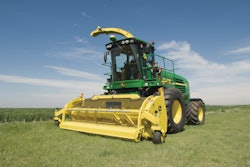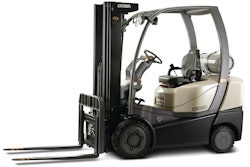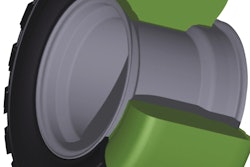Referring to Tier 4 as an evolution rather than an industry event, Caterpillar Group President Stu Levenick says, “we began this journey with Tier 1 in 1996, and with each new tier we continue to build upon our proven technologies, product development and dealer network.”
Caterpillar’s Tier 4 Interim and European Stage IIIB engine strategy includes an integrated system design built on the company’s ACERT technology, the key enablers for achieving a 90% reduction of particulate matter (PM) and a 45% reduction of oxides of nitrogen (NOx).
To the engine, it adds a fully integrated Cat Clean Emissions Module (CEM) and NOx Reduction System (NRS).
“Tier 4 Interim/Stage IIIB is the most aggressive and expensive product development initiative in Caterpillar history,” Levenick says. The company’s significant research and development costs, which reportedly averaged $6 million a day last year, are primarily due to the new product introduction programs to ensure emissions compliance. For Caterpillar’s internal applications alone, that involves more than 300 products.
Caterpillar’s engineers are working three shifts, covering 24 hours a day, 7 days a week—a move that’s unusual for Cat but illustrates the level of work to be done and the short amount of time in which to do it. Between each shift, engineers hand off updates to the incoming group. Thanks in part to this ’round-the-clock schedule, Caterpillar projects it will have nearly one million hours of testing on Tier 4 Interim/Stage IIIB engines and machines by the end of this year.
While the details have not yet been finalized, pricing will likely increase for certain machines by as much as 12% over the Tier 4 Interim/Stage IIIB introduction time frame. Caterpillar anticipates the first increase, starting Jan. 1, 2011, to be about one third of the total amount.
Transparent by design
It’s often said that by the time these tight regulatory deadlines are reached in 2014, the air going into an engine will be dirtier than what leaves the exhaust pipe. Ultimately, however, these engine-driven machines are designed to move dirt and rock, not scrub the air.
“This is not about simply getting past the emissions gate—every company will make that happen,” says Jim Parker, vice president, Caterpillar. “The technology exists to help meet those regulations. The key to success is in how your products look and perform after Tier 4 Interim and Tier 4 Final.”
According to Parker, Caterpillar’s voice-of-the-customer research revealed its customers knew cleaner burning engines were important: “they understand their social responsibility, and they don’t want to be working in a dirty industry. But at the end of the day, they still needed a machine that would increase their productivity.”
The components that will be added to meet emissions regulations should be transparent to the end-user, says Tana Utley, Caterpillar’s chief technology officer. She believes ensuring that transparency is part of the mission for engineers at Caterpillar’s sprawling Technical Center campus in Illinois as well as at centers in England, Japan, China and elsewhere.
“By understanding each business our customers are in, we can look at the technology we have and use it to create products that meet their unique expectations.” Consider altering combustion pressures, next-generation air systems, optimizing fuel delivery, and specifying modular aftertreatment devices for each horsepower band.
That philosophy can be seen in the production and management of the CEM. “Think if each of the 300 Cat machines affected by this change required different CEMs with different installation requirements. We have moved from well over 100 unique CEM installations to a more manageable number by treating it as a family of products. It goes down an assembly line and gets validated to exacting standards.”
Caterpillar’s Tier 4 Interim strategy has also been designed with Tier 4 Final in mind: “We didn’t want to make people redesign for Final,” says Utley. “With the CEM, we designed the package such that if we elect to employ NOx aftertreatment for final, we can do it within this module.”
OEM customers considered
Caterpillar is working to ensure a seamless integration of Tier 4 Interim industrial engines for its OEM customers, as well.
In February, Caterpillar announced five Tier 4 Interim/Stage IIIB industrial engines. The models cover the 385 hp C13 ACERT to the 1,200 hp C32 ACERT. The addition of these five engines completes the introduction of the Cat Industrial Tier 4 Interim/Stage IIIB line, with more than 20 engines. All engines are available with an extensive choice of options to meet end-user and OEM customer requirements across a wide range of applications.
A year and a half ago, Caterpillar’s industrial engine engineers began meeting with its OEM customers and dealers in Tier 4 Integration Workshops (TIW) to get the key people in each group together to understand how they were going to integrate Caterpillar’s engine aftertreatment systems into their equipment.
Equipped with Pro-E files and benefiting from ready access to engine experts, the workshops enabled detailed package and installation reviews. “When OEMs leave the TIW,” says Mike Reinhart, industrial engine marketing manager, “they have a Tier 4 Interim/Stage IIIB engine installation that they know will fit and that they know will power their applications with Cat power. They also understand some of the changes that will be required at the OEM level.”
The workshops have also been a way for Caterpillar engineers to gauge the level of readiness. On average, they believe OEMs are getting ready to meet the regulations, although there is still much work to be done before January 1, 2011.
Pretzels, beer and clean engines
Munich will be the place to see new powerplants.
In Munich, Germany, during the 29th Bauma Intl. Trade Fair, April 19-25, you’re virtually guaranteed a selection of good drink and food, which could include but is not limited to pretzels, pork knuckles and beer. You’ll find some of that on the show floor, mixed in with the latest Tier 4 Interim/Stage IIIB engines from industrial engine suppliers worldwide. Below are a few of the new products to look up at Bauma.
- Caterpillar will showcase Tier 4 Interim/Stage IIIB ACERT engines as well as its Cat Clean Emissions Module (CEM) and the NOx Reduction System (NRS).
- Cummins will show four engines for Tier 4 Interim. The four-cylinder QSB3.3 and QSB4.5 engines for compact equipment utilize a simple variable-flow turbocharger. Cummins will also show the QSX11.9 and QSX15 heavy-duty engines with its XPI common-rail fuel system. The engines feature a scaled-down cooled-exhaust gas recirculation (EGR) system and Cummins’ particulate exhaust aftertreatment. Its Direct Flow air cleaner reduces space claim by up to 35% compared to Tier 3 filters with equivalent or longer service intervals. Cummins will also release its 3,500-hp, 78 liter QSK78 mining engine. The V-18 QSK78 features a full-authority electronic management system, enabling engine parameters to be customized to precisely match the duty cycle of the equipment. QSK engines can handle high-hour and high engine load factors fuel-efficiently and achieve uptime levels over 95%.
- Deutz will feature a range of engines and exhaust gas aftertreatment components.
- Perkins will be presenting a range of industrial engines which are compliant with emissions regulations Tier 4 Interim and IIIB – for example, its new 854 Series. The compact four-cylinder 3.4-liter engine 854E delivers between 60 and 115 hp. From 2011 engines will be available in a range of 2,200 to 2,500 rpm. They are fitted with a common-rail fuel injection system, a waste-gated turbocharger and aftercooler, all electronically controlled. The 1206-E70TTA (shown) is a 7 liter, six-cylinder unit capable of producing 225kW (300 hp) which represents a 21% increase in power over Perkins’ current 6.6 liter offering, giving OEMs who may have previously chosen a larger engine, the choice of the same power from a smaller engine package. The model is fitted with two turbochargers mounted in series. The smaller first stage turbo accelerates quickly, giving excellent response and torque at low speeds, while the larger second stage provides high airflow for power density.
- Scania will be also presenting new engines for industrial applications (right). Scania has chosen to use SCR (selective catalytic reduction) in combination with the common-rail fuel injection system for industrial off-road applications.

















